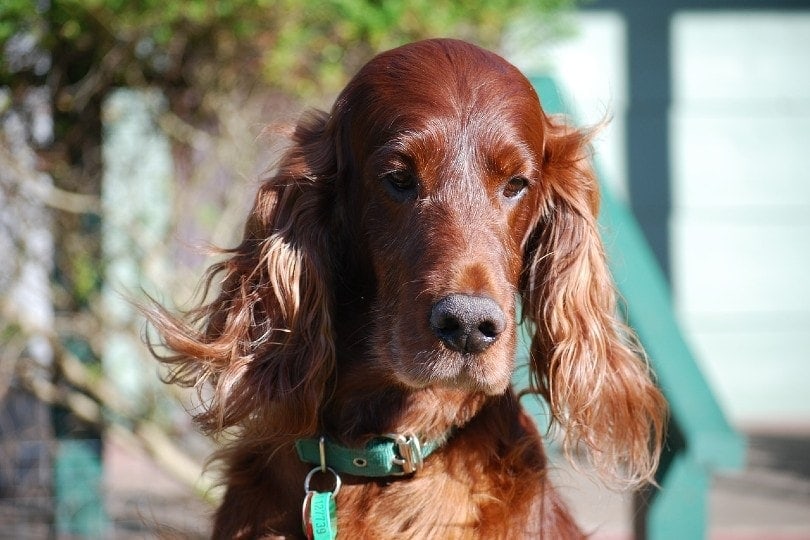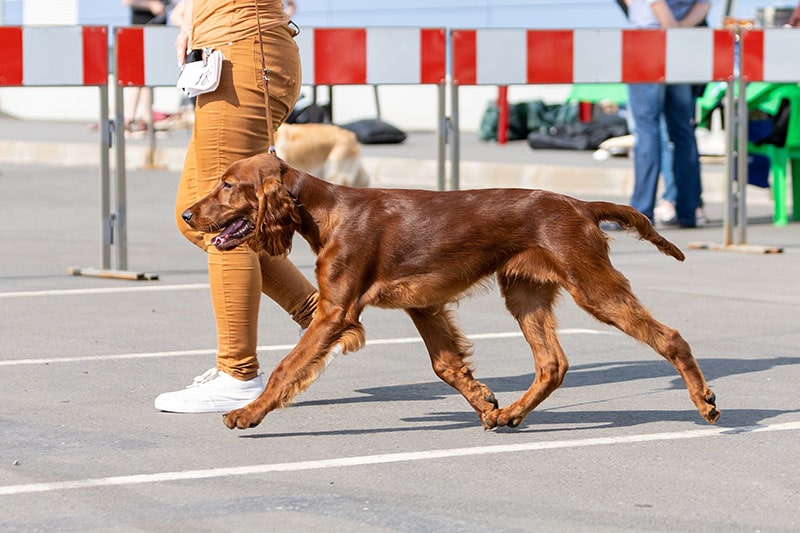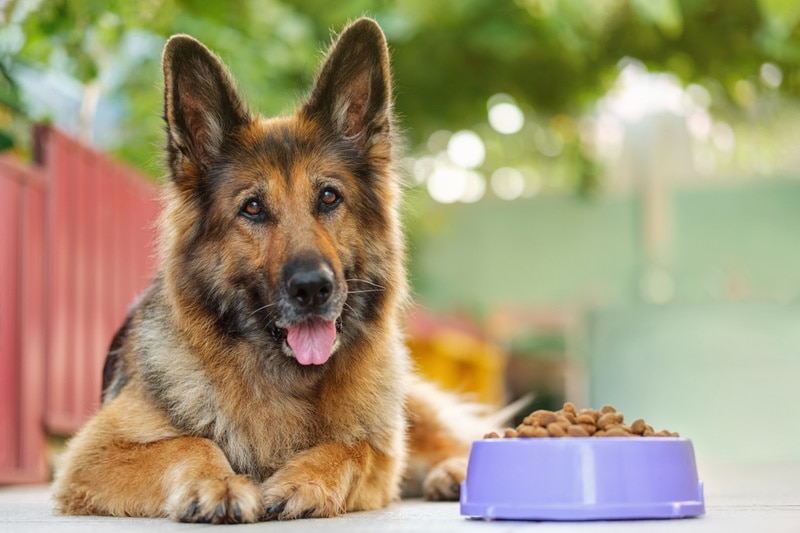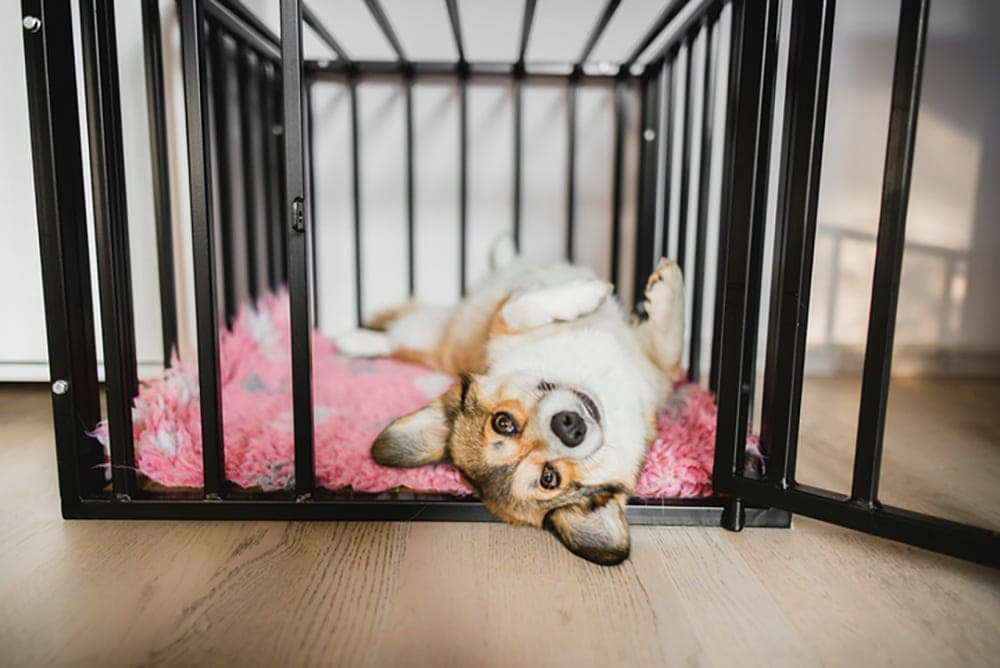How to Train Irish Setters: 11 Tips & Tricks

Updated on

The Irish Setter is a beautiful, proud-looking dog. It is best known for its stunning long red coat, but the breed is more than just an attractive canine. They were bred as gundogs and used their acute sense of smell to locate game birds and would then lay down on its belly to let the hunter know that it had found them.
Today, the breed is still used as a hunting dog but is also commonly kept as a companion pet. It is a popular breed because it is gracious, friendly, loving, and loyal. They are also intelligent dogs but can be stubborn and because they mature slowly, can also have bursts of puppylike behavior, which can make training a bit of a challenge.
Below are 11 tips to help you train your Irish Setter so that you have a well-adjusted dog that is well-behaved and listens to commands.
The 11 Tips on How to Train Irish Setters
1. Start Young
While it isn’t necessarily true that you can’t teach old dogs new tricks, it is certainly true that it is easier to teach a puppy. You can start training as soon as you bring a puppy home. This doesn’t mean you should try to teach commands like heel, but you can teach good manners and even start to work on some basic commands like sit. It is also a good time to start with house training.

2. Be Positive
Positive reinforcement is more effective than negative training techniques. This means ignoring or correcting unwanted behavior, rather than scolding or admonishing it. It also means praising and rewarding positive behavior. This kind of training is often accompanied by the rewarding of treats and the lavishing of praise.
Your dog will eventually associate the rewards and treats with the positive behavior it exhibited, and it will repeat the behavior in the hope of getting more praise and rewards.
3. Provide Lots of Exercise
If a puppy has a lot of pent-up energy, it will find it difficult to concentrate on the task at hand. They will notice more distractions and training will take longer and be more challenging. Before training sessions, ensure your dog has been properly exercised. Go for a long walk or throw a ball around the garden.
4. Use High-Value Rewards
If you are going to use rewards, you can use dry dog kibble for general everyday training, but if you are struggling to keep your Irish Setter’s attention, use higher-value rewards. The rewards should still be healthy, and you can intersperse their use with more basic treats to keep costs down and prevent weight gain, but the high-value rewards will prove especially useful if your dog loses concentration when out walking, for example.

5. Remove Distractions
Some training needs distractions. If you’re training your dog to walk calmly and ignore what’s going on around them, for example, you will want something for your dog to ignore. Otherwise, distractions are bad. And if you have too many distractions around your training area, you are essentially setting your dog up to fail.
If you have other pets, keep them out of the way. Ask other family members not to get involved or be too close to the training and remove any other distractions before you start.
6. Keep Sessions Short
Long training sessions can become boring, and a bored dog is less likely to concentrate. One way to prevent this boredom is to keep sessions short. With a very young pup, this might mean training for a few minutes before calling it a day and waiting for the next session.
As the dog gets older, you can increase the length, but if you see signs of your dog’s attention wandering, think about how long you have been working and whether it might be time to call it a day.
7. Go to Puppy Classes
Puppy classes don’t just teach your puppy how to behave, they are great for socializing, and they also teach you how to effectively train your dog. You can find puppy classes in most areas, and most classes will accept dogs of all breeds and sizes. Sign up, go every week, if you can, and you will reap the rewards.

8. Teach the “Come” Command
The “come” command teaches your dog to come to you, and typically sit in front of you. It also gets your dog’s attention and can be used as a means of distraction. As such, this one command can be used to stop most bad behavior and it forms the basis of a lot of other training.
Use treats when you teach this initially and reward your dog as soon as they respond. Give praise as well as the treat and, over time, you will be able to reduce the number of treats you give and just offer praise.
Sit is another good command that can be used to prevent jumping up and other unwanted behaviors.
9. Turn Training into a Game
Irish Setters mature slowly, which means yours will act like a puppy until it is well over a year old. While puppies are quick studies, they also get distracted easily, and if they find something boring, their attention will wander quickly.
Turn training into a game and it will make it easier for both of you. You will enjoy training so will be more likely to do it every day. Your Irish Setter will enjoy the experience more and will concentrate longer. It will also help develop a bond between the two of you.
10. Consider Crate Training
Crate training can be a highly effective tool and it isn’t cruel. Your dog’s crate will become a safe haven and a spot where your dog doesn’t have to worry about anything. If you give a treat and praise when they get in their crate, they will willingly get in of their own accord eventually. It can be a good way to calm an anxious Red Setter and somewhere for your dog to sleep to prevent restless nights and nighttime guarding.
11. Be Patient
Above all, you need to be patient when you first start training your dog. It is a learning experience for both of you, and your dog won’t instinctively know what you want them to do. There will also be times when they don’t get it right the first time, and some commands and training can take much longer.
Be patient because if you get frustrated or angry, your dog will not want to repeat the session and every training session will get increasingly difficult.

Frequently Asked Questions
Are Irish Setters Easy to Train?
Irish Setters are intelligent dogs, and they are loyal and loving. This combination means that they can be trained very effectively. However, they can also be independent, and because they mature slowly, they can be quite puppylike in their behavior. Start young, keep sessions short, and use positive training techniques, and you should enjoy successful training with your dog.
What Age Do Irish Setters Calm Down?
These slow-maturing dogs can take as long as 2 or even 3 years to calm down, and even adult Irish Setters will have moments of madness and mischief. To many owners, these moments are part of the appeal of the breed, but they can be frustrating to a first-time Setter owner. Be patient, don’t lose your temper, and make sure you give plenty of exercise.
Conclusion
Irish Setters are active, lively dogs. They can be quite silly, and they have an independent streak. While they make excellent pets in the hands of the right owner, they can be a little more challenging to train than breeds like Labradors and Poodles.
Be consistent and patient, use rewards and praise to encourage good behavior, and try to make training sessions enjoyable for both of you.
Featured Image Credit: No-longer-here, Pixabay











